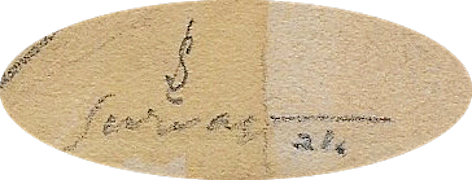

(Moscow, 1879 - Paris, 1968)

Survage was directed to enter the piano factory operated by his Finnish father, and besides learning the piano he took a commercial diploma in 1897. After becoming severely ill at the age of 22, he rethought his career and entered the Moscow School of Painting, Sculpture and Architecture. Introduced to the modern movement through the collections of Sergey Shchukin and Ivan Morosov, he joined the ranks of the Moscow avant-garde and by 1906 was close to the circle associated with the magazine Zolotoye runo.
Leopold Survage settled in Paris in 1908 and worked as a piano tuner and briefly attended the short-lived school run by Henri Matisse. He was influenced by Cezanne and later by Cubism.
He exhibited with the Jack of Diamonds group in Moscow in late 1910, but he first showed his work in France (at the urging of Archipenko) only in the Salon d’Automne of 1911.
Inspired by trends in abstract and cubist painting and the burgeoning development of cinematic techniques, Survage began work on his rhythm-colour “symphonies in movement.” Survage said of his work in the area that, “Coloured music is in no way an illustration or an interpretation of a musical work. It is an autonomous art, although based on the same psychological principles as music”.The numerous descriptions of Survage's completed plates. These descriptions, which are too lengthy to quote in full, and the few frames presented as examples, bear an uncanny similarity to the descriptions of coloured photisms resulting from chromaesthesia. Unfortunately his work on coloured rhythm was never completed.
Leopold Survage was described by the avant-garde poet and critic Guillaume Apollinaire as the creator of “a new art of painting in motion.” Survage believed that what he called “colored rhythm” was based on the same psychological premises as music, it was not an illustration or an interpretation of musical work. His creations historically settled him among abstraction artists as Delaunay, Kupka, Mondrian and Malevitch.
His cubism wasn’t orthodoxe. He used what he called a “plastical synthesis of the space”, translation of the space in two dimensions which he preferred to volumetric analysis, linked to analytical cubism.
Survage was also the author of set piece for Marva, a ballet from Diaghilev, as well as large decorative panels for the Pavilion or Railways at the International Exhibition of 1937, for which he received a gold medal. In 1954, he participated at the Venice Biennale. In 1960, he was awarded the Guggenheim Prize for his painting Maternité (1958). Several exhibitions were dedicated to him, at Nimes Museum (1969), Saint – Etienne Museum, Sables d’Olonne (1973), Nice (1975), and most recently a retrospective at Troyes (MAM in 1993).